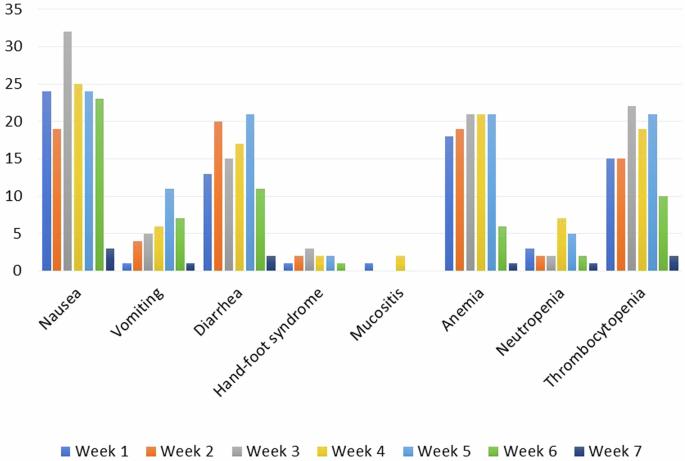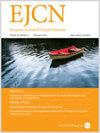Impact of low muscle mass and myosteatosis on treatment toxicity and survival outcomes in non-resectable pancreatic cancer patients treated with chemoradiotherapy
IF 3.3
3区 医学
Q2 NUTRITION & DIETETICS
引用次数: 0
Abstract
Low skeletal muscle mass and impaired muscle quality (myosteatosis) have been associated with poor outcomes in cancer patients. This study aimed to evaluate the impact of pre-therapeutic low muscle mass and myosteatosis on chemoradiotherapy (CRT)-induced toxicity and survival outcomes in patients with non-resectable pancreatic cancer (PC). In this retrospective study, pre-therapeutic CT scans were used to measure muscle mass/density. Low muscle mass was defined as a skeletal muscle index <38.5 cm²/m² (women) and <52.4 cm²/m² (men), and myosteatosis as a mean psoas density <41 HU if BMI < 25 kg/m² or <33 HU if BMI > 25 kg/m². Adverse effects were collected per week (W) of treatment. Dose-limiting toxicity (DLT) was defined as any toxicity leading to dose reduction, treatment delays or permanent discontinuation. Among the 85 included patients, 75 (88.2%) and 18 (22.2%) had pre-therapeutic low muscle mass and myosteatosis, respectively. Only 12 patients (14.1%) experienced DLT. Patients with low muscle mass developed significantly more toxicities at W2 (p = 0.013) and W5 (p = 0.026), notably more nausea (p = 0.037) and anemia (p = 0.004). Low muscle mass was associated with poorer overall survival (HR 4.41 [1.50–12.94], p = 0.007) in multivariate Cox analysis, while myosteatosis was not associated with CRT toxicities, DLT and overall survival (p = 0.408). Patients with low muscle mass experienced more toxicities and poorer outcomes during CRT for non-resectable PC.

低肌肉量和肌骨化病对不可切除胰腺癌放化疗患者治疗毒性和生存结果的影响。
背景:骨骼肌质量低和肌肉质量受损(肌骨增生症)与癌症患者预后不良相关。本研究旨在评估治疗前低肌肉量和肌骨增生症对不可切除胰腺癌(PC)患者放化疗(CRT)诱导的毒性和生存结果的影响。方法:在这项回顾性研究中,使用治疗前CT扫描测量肌肉质量/密度。低肌肉质量定义为骨骼肌指数为25 kg/m²。每周收集不良反应(W)。剂量限制性毒性(DLT)被定义为任何导致剂量减少、治疗延迟或永久停药的毒性。结果:85例患者中,75例(88.2%)和18例(22.2%)患者在治疗前分别出现低肌量和肌骨化症。只有12例患者(14.1%)经历了DLT。肌肉量低的患者在W2 (p = 0.013)和W5 (p = 0.026)时明显出现更多的毒性,尤其是恶心(p = 0.037)和贫血(p = 0.004)。在多变量Cox分析中,低肌肉质量与较差的总生存期相关(HR 4.41 [1.50-12.94], p = 0.007),而肌骨化症与CRT毒性、DLT和总生存期无关(p = 0.408)。结论:对于不可切除的PC,低肌肉质量的患者在CRT中毒性更大,预后更差。
本文章由计算机程序翻译,如有差异,请以英文原文为准。
求助全文
约1分钟内获得全文
求助全文
来源期刊
CiteScore
10.60
自引率
2.10%
发文量
189
审稿时长
3-6 weeks
期刊介绍:
The European Journal of Clinical Nutrition (EJCN) is an international, peer-reviewed journal covering all aspects of human and clinical nutrition. The journal welcomes original research, reviews, case reports and brief communications based on clinical, metabolic and epidemiological studies that describe methodologies, mechanisms, associations and benefits of nutritional interventions for clinical disease and health promotion.
Topics of interest include but are not limited to:
Nutrition and Health (including climate and ecological aspects)
Metabolism & Metabolomics
Genomics and personalized strategies in nutrition
Nutrition during the early life cycle
Health issues and nutrition in the elderly
Phenotyping in clinical nutrition
Nutrition in acute and chronic diseases
The double burden of ''malnutrition'': Under-nutrition and Obesity
Prevention of Non Communicable Diseases (NCD)

 求助内容:
求助内容: 应助结果提醒方式:
应助结果提醒方式:


